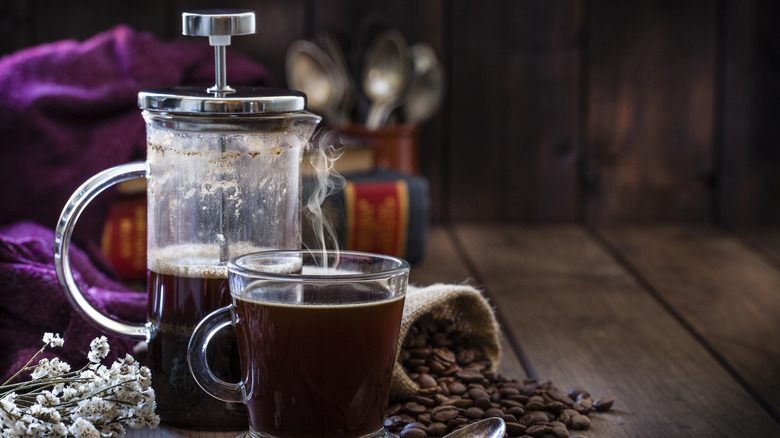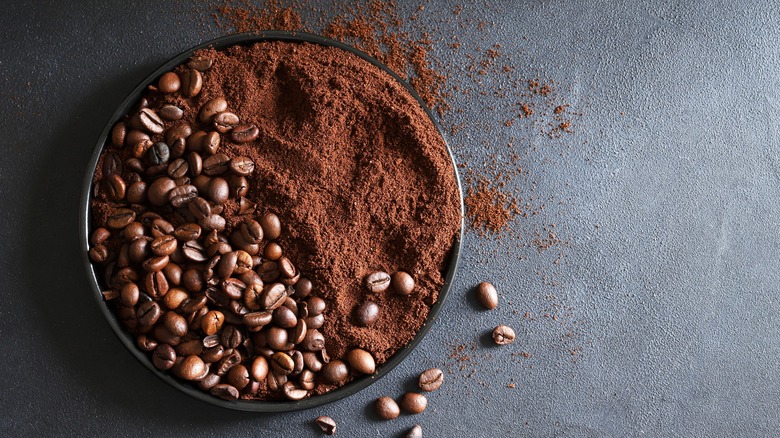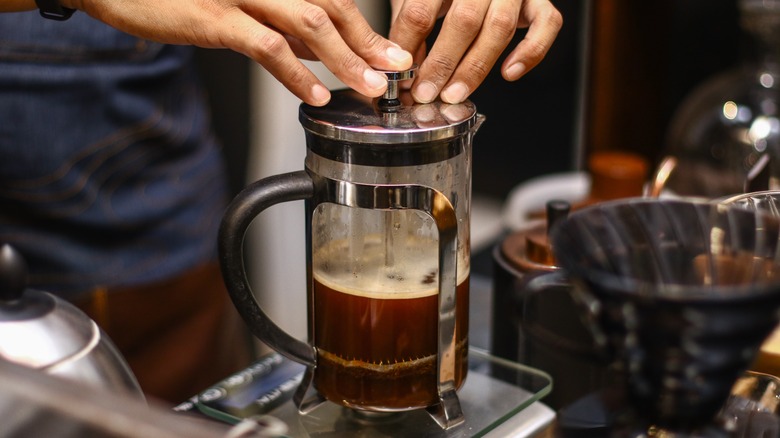The Ratio Tip For Setting Your French Press Coffee Up For Success
If you're taking your first tentative steps into the wonderful world of manual coffee making, take our advice — we think the humble French press is one of the best ways to brew coffee. Not only are these things easy to use, but they put so much control in your hands: The type of coffee you'd like to try, the length of the steep, the strength of the brew. Since all you're basically doing is adding ground coffee beans and hot water, letting it steep, and pushing down on a plunger, the first rule of the French press is to know the standard water-to-coffee ratio. Start with 1 part ground beans to 12 parts water, or 1 tablespoon coffee for every cup of water.
If you have pre-ground coffee, then you're off to the races. (Just ignore the directions on the back of the coffee bag.) However, if part of your bespoke brewing kit includes a coffee grinder along with your French press, set the grind to medium-coarse. This is the Goldilocks size for French press coffee grounds; they're not so espresso small that they clog up the filter but are large enough for optimal extraction. Put the desired amount of grounds into your French press, then heat your water. Bringing the water to a boil is perfectly fine if you only have a kettle. If you can control the water temperature, set it to 200 F or just below boiling.
Grind, heat, and bloom
Ratios are ideal because they're scaleable. Want to brew up only a cup for yourself? Measure out a tablespoon of grounds! Want to make coffee for your friends with a standard, 1-liter French press? A generous quarter cup of coffee should do the job. Of course, this is just for reference; it's not a hard and fast rule. It all comes down to how strong you like your coffee, and by "strength," we mean a higher coffee-to-water ratio as opposed to a darker roast. The reason a shot of espresso is so noticeably strong is because it's made with a 1:2 coffee-to-water ratio.
Don't dump that water all over the coffee just yet! You will want to allow the grounds to "bloom" or release carbon dioxide. This is important for two reasons: Carbon dioxide has its own flavor, which is generally described as sour — there's no need to keep that around. Second, the gas gets in the way of the water, extracting the flavors, aromas, and oils from the coffee. Bloom your grounds by pouring about twice as much water as coffee over them and let them sit for 30 seconds. You should see bubbles (signifying the release of carbon dioxide gas), followed by the formation of a crust. Now you're ready to brew.
The waiting is the hardest part (not really)
Next, pour the remaining water over the grounds (you don't have to do this slowly — the extraction process will happen later) and give it a gentle stir. Then, place the French press plunger assembly on top and push it down until it touches the liquid. Then, walk away and let the magic happen. You might think that the amount of coffee grounds you use would be the only metric for the strength of the brew, but the length of extraction time will also produce stronger or weaker coffee. The standard French press extraction time is four minutes. When that's done, push the plunger down slowly, as far as it will go, and pour your first exquisite cup.
Like tea, you can under- or over-extract your French press coffee. Under-extracted coffee will be a weak brown color, lacking in body and sweetness. It might even be sour. Conversely, over-extracted coffee will be bitter with a tannin-like astringency. If that's how you like to roll, go for it — but try the four-minute extraction method first, then decide which way to go. After all, you have all the control.


